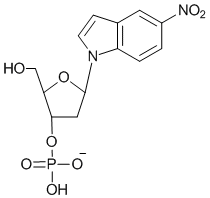5-Nitroindole Amidite
5-Nitroindole Amidite
5-Nitroindole Amidite, 250 mg, ABI (5 mL / 20 mm Septum)
Key features
Show- Used as a universal base to alleviate degeneracy in sequencing applications.
- Confers stability by acting as an intercalating agent, with equal interaction across all four bases.
- Superior to previous 3-nitropyrrole products.
Usually shipped in 10-15 Days, Made To Order
Product information
In sequencing applications, the design of primers can be complicated by the degeneracy of the genetic code (there are 64 possible 3-base codon configurations and only 21 amino acids, and therefore the third base in a sequence codon is often unknown). The problem of degeneracy can also be tackled by the use of universal bases.(1) Deoxyinosine is often used as a degenerate base in an oligonucleotide to alleviate this problem.(2) This is possible since its structure allows it to base pair with all four bases in various ‘wobble’ structures. However, the base-pairing is not equivalent with each of the 4 naturally occurring bases. The overall preferential order of base-pairing is: dI-dC > dI-dA > dI-dG = dI-dT. We provide both dI phosphoramidite and CPGs. 2'-Deoxynebularine(3) is another example. In a true universal nucleoside, the base analogue does not hybridize significantly to the other four bases and makes up some of the duplex destabilization by acting as an intercalating agent. 3-nitropyrrole 2'-deoxynucleosides were the first example of a set of universal bases. Subsequently, 5-nitroindole was determined to be an effective universal base and to be superior to 3-nitropyrrole, based on duplex melting experiments.
Ref:
- The applications of universal DNA base analogues, D. Loakes, Nucleic Acids Research, 29, 2437-2447, 2001.
- (a) Base pairing involving deoxyinosine: implications for probe design, F.H. Martin, M.M. Castro, F. Aboul- ela and I. Tinoco, Jr, Nucleic Acids Research, 13, 8927-8938, 1985; (b) Studies on the base pairing properties of deoxyinosine by solid phase hybridisation to oligonucleotides, S.C. Case-Green, E.M. Southern, Nucleic Acids Research, 22, 131-136, 1994.
- (a) Synthesis and properties of oligonucleotides containing 2'-deoxynebularine and 2'-deoxyxanthosine, R. Eritja, D.M. Horowitz, P.A. Walker, J.P. Ziehler-Martin, M.S. Boosalis, M.F. Goodman, K. Itakura and B.E. Kaplan, Nucleic Acids Research, 14, 8135-8153, 1986; (b) As a custom item we have prepared the phosphoramidite, see: A convenient synthesis of deoxynebularine phosphoramidite, D. Picken and V. Gault, Nucleosides, Nucleotides and Nucleic Acids, 16, 937-939, 1997. Please enquire regarding availability.
Properties:
- Formula: C43H49N4O8P
- Molecular Weight: 780.86
- Appearance: pale yellow solid
- Extinction Coefficient at 260 nm: 16000
Product usage:
- Synthesis conditions: Follow the instrument manufacturer's protocol when using this product. Prior to dilution ensure that all product is at the bottom of the vial. Dilute to the recommended concentration and mix thoroughly in the sealed vial to ensure that all contents are dissolved.
- Dilution: 100 µmol/1mL
- Deprotection conditions: The deprotecting conditions for this amidite will depend on the types of amidites used for the synthesis of the oligo. If using fast deprotecting amidites, deprotect in concentrated ammonia for 2 hours at 60 °C. If using standard amidites deprotect in concentrated ammonia for 5 hours at 60°C. 1. David Loakes The Applications of universal DNA base analogues. Nucleic Acids Research, 2001, Vol.29, No. 12 2437-2447Image of cleaved and deprotected structure:
- The mass this product adds after conjugation and work-up (the additional mass seen by mass spectrometry) is: 340.43

Storage and handling:
- Shipping conditions: Cold
- Storage conditions: -15 to -30 °C
Access support
Need some support with placing an order, setting up an account, or finding the right protocol?
Contact us